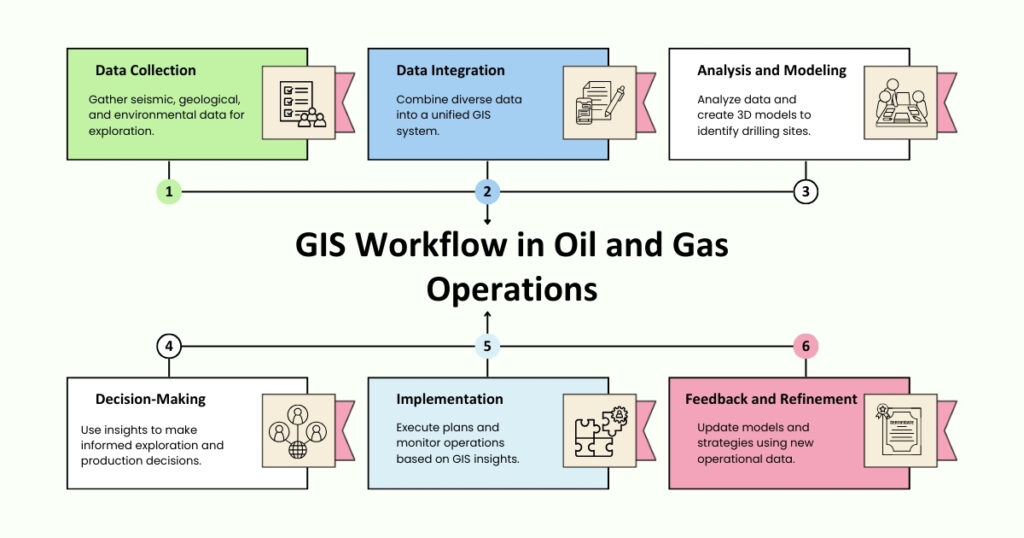Do you know the integration of GIS across various sectors, including oil and gas, is projected to grow at a CAGR of 12.5% and reach a market size of US $26.27 billion between the periods of 2024-30? With this growth, oil and gas companies are adopting GIS mapping services. GIS helps in optimizing pipeline routes and monitoring assets in real-time. It also improves safety protocols and analyzes large amounts of spatial data. This integration streamlines operations, reduces risks, and enhances decision-making.
To know more about how GIS technology integration helps in achieving optimal results, read the blog that covers various aspects of the GIS mapping services integration with the oil and gas technology sector.

What is the Role of GIS mapping services in the Oil and Gas Sector?
GIS plays an important role in streamlining operations and saving costs in the oil and gas sector, we will discuss each factor in detail through the below-mentioned pointers:
Exploration and Production (E&P)
- This is the first stage in the oil and gas lifecycle; GIS here helps to integrate historical records, geological maps, seismic data, etc., to create effective reservoir modeling.
- With these integrations, we identify locations for resource extraction and drilling. It helps in improving the accuracy of finding drilling locations and results in reduced exploration risks.
- Reservoir modeling: a GIS mapping services feature helps visualize and model the size of the reservoir so accurate production estimates can be made.
Asset Management and Infrastructure
- Asset Management and Infrastructure in the Oil and Gas Sector with GIS is important for cost-effective infrastructure management, including storage, refineries, pipelines, rigs, etc.
- Through spatial databases, GIS helps in asset maintenance and tracking. Operators can effectively determine on one single platform how the asset will be distributed across geographic locations, such as the exact location of pipelines, storage tanks, etc.
- GIS technology also aids in optimized infrastructure planning by enabling optimal site selection, environmental considerations, and cost optimization. Additionally, it reduces risks through data integration from drones and satellites, allowing for in-depth inspections, particularly in offshore rigs and remote pipeline locations.
Pipeline and Route Optimization
- In the oil and gas sector, pipelines are the foundation for transporting crude oil, natural gas, and other petroleum products over long distances that can be challenging. Here, GIS plays a role in route optimization through planning and design, which is done by geospatial analysis of factors like terrain, land use, and environmental sensitivity. Route optimization is done for cost savings and less environmental disruption.
- Listed below are a few important features offered by GIS for pipeline and route optimization.
- Terrain and elevation analysis through slope stability analysis and analysis of elevation profiles
- Integrating existing pipeline networks and faster access to maintenance facilities. Through predictive maintenance, one can perform a better assessment of temperature variations, terrain type, seismic activity, etc.
- Enhancing risk management and safety through population density analysis, identification of high-risk zones, emergency response planning, etc.
Field Data Collection and Remote Sensing
-
- Other key aspects include real-time field data collection through GPS integration and geotagging, environmental impact monitoring, sensitive ecosystem tracking, regulatory audits and inspections through data maps, etc.
Seismic Data Analysis and Fault Line Mapping
- Integrating GIS in India with seismic data analysis enhances vibrational data acquisition, and then we use geophones or hydrophone sensors to collect information on wave reflection.
- Integration data also helps engineers analyze subsurface geological formations in 2D or 3D form.
- GIS integrates seismic surveys, geological maps, and satellite imagery, which helps identify fault lines so that companies can make changes in drilling plans, develop stronger infrastructure, and develop safety protocols to mitigate the impact.
Advantages of GIS mapping services in the Oil and Gas Sector
The geographic information system helps the oil and gas sector by integrating tools that help in data management through data layering, emergency response planning, data sharing and collaboration, and more. Listed below are some key advantages:
- Optimized Exploration and Drilling Operations
- Supply Chain and Logistics Optimization
- Enhanced Pipeline and Infrastructure Management
- Sustainability through Optimized Resource Utilization
- Reduction in Maintenance Costs
- Enhanced Emergency Response and Incident Management
- Enhanced Communication and Collaboration
GIS Innovations and Trends Integrated by GIS Companies in India
Listed below are a few upcoming GIS trends and innovations contributing to the transformation of the oil and gas industry:
- Real-time data integration, such as satellite imagery and IoT sensors
- AI and Machine learning for anomaly detection and optimization
- Advanced geospatial analytics such as 3D modeling and spatial analysis
- Blockchain for Data Security
- Remote Sensing and UAVs through high-resolution aerial imagery and data collection
- Enhanced reservoir modeling that helps in accurately predicting oil and gas reserves.
Conclusion
Integrating GIS technology in the oil and gas industry not only enhances operational efficiency but also transforms how we manage and ensure our resources and safety. By utilizing advanced spatial data analysis and innovative technologies, companies can achieve precise monitoring, proactive maintenance, and optimized resource usage. This strategic integration drives significant improvements, offering a competitive edge and unlocking new levels of operational excellence. Using these GIS capabilities could redefine your approach to industry challenges, setting the stage for future advancements and sustained success.
If you are looking to capitalize on the benefits of GIS mapping services in the oil and gas industry solutions, then getting expert guidance from SCS Tech India can be an optimal decision. Their solutions enhance precision, streamline management, and drive innovation, giving you a competitive edge while maximizing efficiency.
FAQ
- Can GIS help in predictive analytics in the oil and gas sector exploration?
Yes, GIS technology helps in predictive analytics in the oil and gas sector exploration by integrating historical data with geospatial information, subsurface mapping, geological risk assessment, hydrocarbon movement prediction, and more.
- Do GIS mapping services help in risk management in the oil and gas industry?
Yes, GIS mapping services help in risk management by identifying high-risk zones, real-time monitoring of assets through drone and satellite monitoring, seismic risk prediction by spatial analysis, etc.
- What are the innovations GIS companies in India are focusing on to transform the oil and gas sector in India?
GIS companies in India are focusing on innovations like advanced remote sensing and satellite imagery, 3D reservoir modeling, seismic data integration, scalable cloud GIS platforms, hybrid energy systems, and more.
- How can we use GIS technology in pipeline management in the oil and gas sector?
GIS technology is important for pipeline management in the oil and gas sector as it helps detect leaks, corrosion, and pressure anomalies, ensure pipeline safety, reduce environmental risks, etc.
Read More: Current Trends in Artificial Intelligence (AI) Application to Oil and Gas Industry
